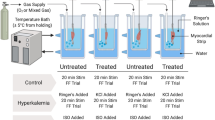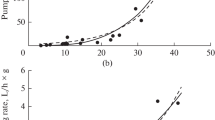Summary
-
1.
The giant scallopPlacopecten magellanicus responds to stimulation with starfish extract by snapping the valves in a series of rapid adductions. After approximately 25–35 adductions, the scallop does not respond to further stimulation, and usually closes the valves.
-
2.
Snapping of the valves results in an accelerated heart rate, increased stroke volume and enhanced cardiac output. The supply of oxygen to the adductor muscle will be increased but must be insufficient, as blood\(P_{{\text{O}}_{\text{2}} }\) decreases to 15 mm Hg and energy-producing anaerobic pathways are invoked (de Zwaan et al., 1980). There is an increase in the total carbon dioxide content of the blood and a fall in blood pH. When the scallop reopens, there is a transient increase in oxygen uptake.
-
3.
The restoration of physiological functions to normal values takes several hours.
-
4.
During valve closure, the\(P_{{\text{O}}_{\text{2}} }\) of the mantle water decreases from 145 mm Hg to 80 mm Hg, blood\(P_{{\text{O}}_{\text{2}} }\) from 85 mm Hg to 40 mm Hg. This is sufficient to maintain a degree of aerobic metabolism, and oxygen uptake continues. There is no change in heart rate, but blood pH decreases gradually.
Similar content being viewed by others
References
Akberali, H.B., Marriott, K.R.M., Trueman, E.R.: Calcium utilisation during anaerobiosis induced by osmotic shock in a bivalve mollusc. Nature266, 852–853 (1977)
Bayne, B.L.: Oxygen consumption by three species of lamellibranch mollusc in declining ambient oxygen tension. Comp. Biochem. Physiol.40A, 955–970 (1971)
Bayne, B.L., Livingstone, D.R.: Responses ofMytilus edulis L. to low oxygen tension: acclimation of the rate of oxygen consumption. J. Comp. Physiol.114, 129–142 (1977)
Bayne, B.L., Bayne, C.J., Carefoot, T.C., Thompson, R.J.: The physiological ecology ofMytilus californianus Conrad. — II. Adaptations to low oxygen tension and air exposure. Oecologia22, 229–250 (1976)
Bennett, A.F.: Activity metabolism of the lower vertebrates. Ann. Rev. Physiol.40, 447–469 (1978)
Booth, C.E., Mangum, C.P.: Oxygen uptake and transport in the lamellibranch molluscModiolus demissus. Physiol. Zool.51, 17–32 (1978)
Dakin, W.J.:Pecten. Liverpool Marine Biology Committee, Memoirs, No. 12, 136 pp. (1909)
Dejours, P., Garey, W.F., Rahn, H.: Comparison of ventilatory and circulatory flow rates between animals in various physiological conditions. Resp. Physiol.9, 108–117 (1970)
Drew, G.A.: The habits, anatomy, and embryology of the giant scallop, (Pecten tenuicostatus Mighels). |=PitPlacopecten magellanicus Gmelin|. University of Maine Studies, No. 6, 71 pp. Orono, Maine (1906)
Johansen, K., Petersen, J.A.: Gas exchange and active ventilation in a starfish,Pteraster tesselatus. Z. Vergl. Physiol.71, 365–381 (1971)
Johansen, K., Lenfant, C., Mecklenberg, T.A.: Respiration in the crab,Cancer magister. Z. Vergl. Physiol.70, 1–19 (1970)
Kiceniuk, J.W., Jones, D.R.: The oxygen transport system in trout (Salmo gairdneri) during sustained exercise. J. Exp. Biol.69, 247–260 (1977)
Mangum, C.P.: The analysis of oxygen uptake and transport in different kinds of animals. J. Exp. Mar. Biol. Ecol.27, 125–140 (1977)
McDonald, D.G., McMahon, B.R., Wood, C.M.: An analysis of acid-base disturbances in the hemolymph following strenuous activity in the Dungeness crab,Cancer magister. J. Exp. Biol. (in press) 1980
McMahon, B.R., Wilkens, J.L.: Periodic respiratory and circulatory performace in the red rock crabCancer productus. J. Exp. Zool.202, 363–374 (1977)
McMahon, B.R., McDonald, D.G., Wood, C.M.: Ventilation, oxygen uptake and haemolymph oxygen transport, following enforced exhausting activity in the Dngeness crabCancer magister. J. Exp. Biol.80, 271–285 (1979)
Moore, J.D., Trueman, E.R.: Swimming of the scallopChlamys opercularis (L.). J. Exp. Mar. Biol. Ecol.6, 179–185 (1971)
Randall, D.J.: Gas exchange in fish. In: Fish physiology, Vol. 4. Hoar, W.S., Randall, D.J. (eds.), pp. 253–292. New York: Academic Press 1970
Stephens, P.J., Boyle, P.R.: Escape responses of the queen scallopChlamys opercularis (L.) (Mollusca: Bivalvia). Mar. Behav. Physiol.5, 103–113 (1978)
Stevens, E.D., Randall, D.J.: Changes in blood pressure, heart rate and breathing rate during moderate swimming activity in rainbow trout. J. Exp. Biol.46, 307–315 (1967a)
Stevens, E.D., Randall, D.J.: Changes in gas concentrations in blood and water during moderate swimming activity in rainbow trout. J. Exp. Biol.46, 329–337 (1967b)
Sutterlin, A.M.: Effects of exercise on cardiac and ventilation frequency in three species of freshwater teleosts. Physiol. Zool.42, 36–52 (1969)
Thomas, G.E., Gruffydd, Ll.D.: The types of escape reactions elicited in the scallopPecten maximus by selected sea-star species. Mar. Biol.10, 87–93 (1971)
Thompson, R.J., Bayne, C.J., Moore, M.N., Carefoot, T.H.: Haemolymph volume, changes in the biochemical composition of the blood, and cytological responses of the digestive cells inMytilus californianus Conrad, induced by nutritional, thermal and exposure stress. J. Comp. Physiol.127, 287–298 (1978)
Vooys, C.G.N. de, Zwaan, A. de: The rate of oxygen consumption and ammonia excretion byMytilus edulis after various periods of exposure to air. Comp. Biochem. Physiol.60, 343–347 (1978)
Wood, C.M., McMahon, B.R., McDonald, D.G.: An analysis of changes in blood pH following exhausting activity in the starry flounder,Platichthys stellatus. J. Exp. Biol.69, 173–185 (1977)
Zammit, V.A.: Possible relationship between energy metabolism of muscle and oxygen binding characteristics of haemocyanin of cephalopods. J. Mar. Biol. Ass. U.K.58, 421–424 (1978)
Zwaan, A. de, Thompson, R.J., Livingstone, D.R.: Physiological and biochemical aspects of the valve snap and valve closure responses in the giant scallopPlacopecten magellanicus. II. Biochemistry. J. Comp. Physiol.137, 105–114 (1980)
Author information
Authors and Affiliations
Rights and permissions
About this article
Cite this article
Thompson, R.J., Livingstone, D.R. & de Zwaan, A. Physiological and biochemical aspects of the valve snap and valve closure responses in the giant scallopPlacopecten magellanicus . J Comp Physiol B 137, 97–104 (1980). https://doi.org/10.1007/BF00689207
Accepted:
Issue Date:
DOI: https://doi.org/10.1007/BF00689207




